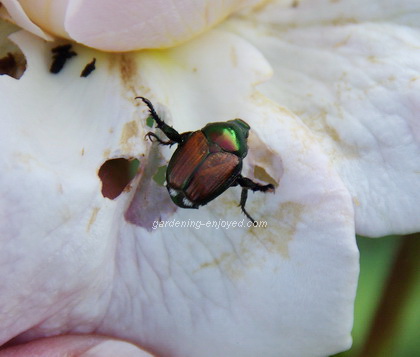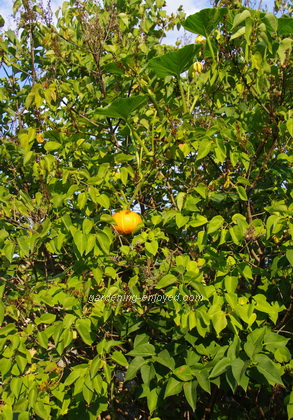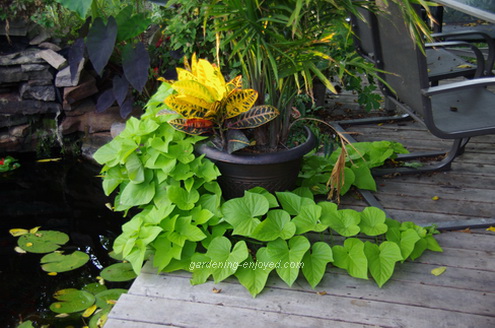| Back to Back Issues Page |
 |
|
Dallying In The Dirt, Issue #232--- The Lilac Squash are astounding visitors again. September 07, 2015 |
 This morning while wandering the garden looking for the pictures that are my inspiration of each of the sections of “Dallying,” I was very unhappy when I peeked at the lovely white Rose in the front garden. There were two of these large ugly beasts tucked between the petals, madly eating away. I have only noticed a Japanese Beetle Popillia japonica once before in my garden and have counted myself lucky. They are horrible pests with a voracious appetite and they are difficult to control. I controlled these two quite quickly with my thumb and forefinger and will now keep a close eye on my other Roses. They like Roses but they are quite indiscriminate when it comes to choosing their next meal. Their larva are white grubs in our lawns and that is a good place to attack them. In our pesticide free environment, the application of Nematodes to the lawn at the correct time of year can be an effective
control. The adults tend to be in clusters and hand picking is probably the best method of controlling them.
This morning while wandering the garden looking for the pictures that are my inspiration of each of the sections of “Dallying,” I was very unhappy when I peeked at the lovely white Rose in the front garden. There were two of these large ugly beasts tucked between the petals, madly eating away. I have only noticed a Japanese Beetle Popillia japonica once before in my garden and have counted myself lucky. They are horrible pests with a voracious appetite and they are difficult to control. I controlled these two quite quickly with my thumb and forefinger and will now keep a close eye on my other Roses. They like Roses but they are quite indiscriminate when it comes to choosing their next meal. Their larva are white grubs in our lawns and that is a good place to attack them. In our pesticide free environment, the application of Nematodes to the lawn at the correct time of year can be an effective
control. The adults tend to be in clusters and hand picking is probably the best method of controlling them. Does your Lilac bush bear fruit? Mine does, but they are very strange. A few large orange fruit can be found hanging in the Lilac at this time of year. It is one of the easiest parts of my vertical vegetable efforts. I simply plant my wandering winter squash near the Lilac bush and as the Squash vines start to grow I twine them up into the adjacent bush and stand back. By late summer there will be several bright orange squash hanging in the Lilac. They are easy to pick and don’t have any slug damage or yellow spot where they were laying on the ground. I should confess that they did this all by themselves the first year and I quickly realized the benefits and now assist them each spring as they start to grow. The vines tend to be inside the Lilac and not readily visible, giving visitors a bit of a surprise when they first walk past.
Does your Lilac bush bear fruit? Mine does, but they are very strange. A few large orange fruit can be found hanging in the Lilac at this time of year. It is one of the easiest parts of my vertical vegetable efforts. I simply plant my wandering winter squash near the Lilac bush and as the Squash vines start to grow I twine them up into the adjacent bush and stand back. By late summer there will be several bright orange squash hanging in the Lilac. They are easy to pick and don’t have any slug damage or yellow spot where they were laying on the ground. I should confess that they did this all by themselves the first year and I quickly realized the benefits and now assist them each spring as they start to grow. The vines tend to be inside the Lilac and not readily visible, giving visitors a bit of a surprise when they first walk past.Now it’s time to answer a few of my reader’s questions. Don’t forget to check the front page of the Website for frequent short ideas for current gardening activities. Donna Asks? A nice grouping of purple coneflower (about 4 years old in this spot) has only produced the cone this year and no flower petals. It looks healthy and this is the first year that this has happened. I know they are rather drought tolerant and like sun. Where it is planted, it gets about half day of sun and it has been dry this summer. I was wondering if I should move it in the fall or try another year? |
| Back to Back Issues Page |
